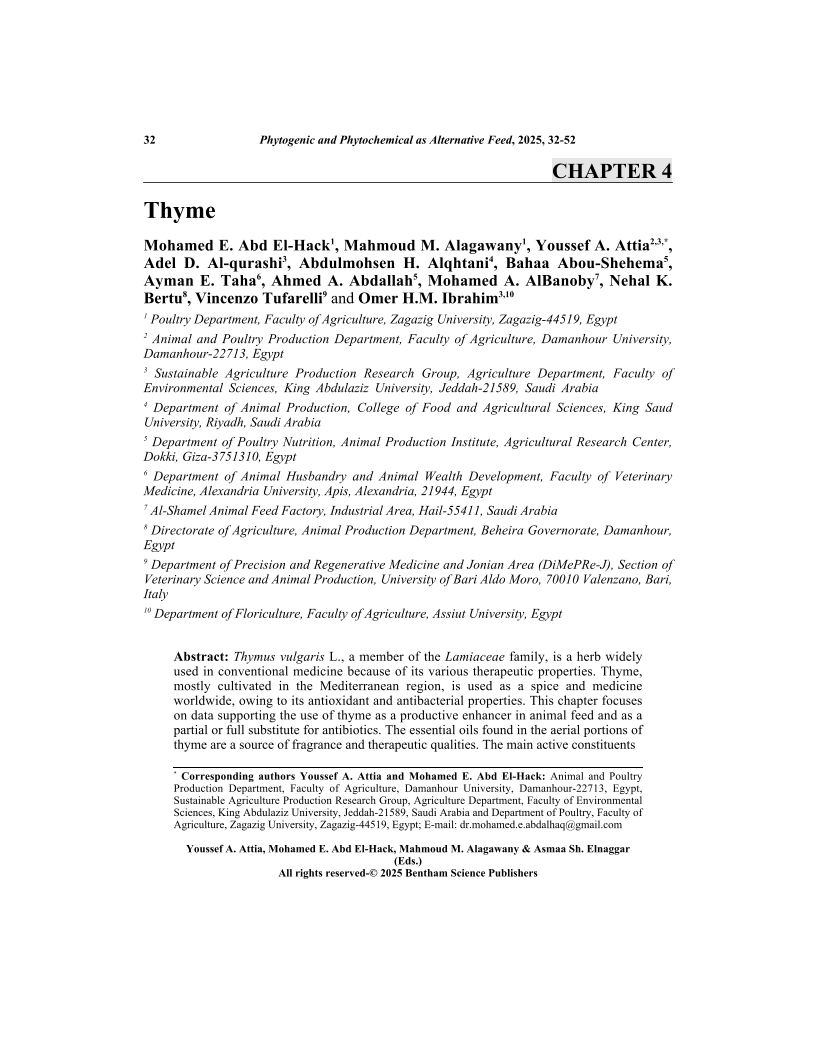Thyme

- Authors: Mohamed E. Abd El Hack1, Mahmoud M. Alagawany2, Youssef A. Attia3, Adel D. Al-qurashi4, Abdulmohsen H. Alqhtani5, Bahaa Abou-Shehema6, Ayman E. Taha7, Ahmed A. Abdallah8, Mohamed A. AlBanoby9, Nehal K. Bertu10, Vincenzo Tufarelli11, Omer H.M. Ibrahim12
-
View Affiliations Hide Affiliations1 Poultry Department, Faculty of Agriculture, Zagazig University, Zagazig-44519, Egypt 2 Poultry Department, Faculty of Agriculture, Zagazig University, Zagazig-44519, Egypt 3 Animal and Poultry Production Department, Faculty of Agriculture, Damanhour University, Damanhour-22713, Egypt 4 Sustainable Agriculture Production Research Group, Agriculture Department, Faculty of Environmental Sciences, King Abdulaziz University, Jeddah-21589, Saudi Arabia 5 Department of Animal Production, College of Food and Agricultural Sciences, King Saud University, Riyadh, Saudi Arabia 6 Department of Poultry Nutrition, Animal Production Institute, Agricultural Research Center, Dokki, Giza-3751310, Egypt 7 Department of Animal Husbandry and Animal Wealth Development, Faculty of Veterinary Medicine, Alexandria University, Apis, Alexandria, 21944, Egypt 8 Department of Poultry Nutrition, Animal Production Institute, Agricultural Research Center, Dokki, Giza-3751310, Egypt 9 Al-Shamel Animal Feed Factory, Industrial Area, Hail-55411, Saudi Arabia 10 Directorate of Agriculture, Animal Production Department, Beheira Governorate, Damanhour, Egypt 11 Department of Precision and Regenerative Medicine and Jonian Area (DiMePRe-J), Section of Veterinary Science and Animal Production, University of Bari Aldo Moro, 70010 Valenzano, Bari, Italy 12 Sustainable Agriculture Production Research Group, Agriculture Department, Faculty of Environmental Sciences, King Abdulaziz University, Jeddah-21589, Saudi Arabia
- Source: Phytogenic and Phytochemical as Alternative Feed Additives for Animal Production , pp 32-52
- Publication Date: March 2025
- Language: English
Thyme, Page 1 of 1
< Previous page | Next page > /docserver/preview/fulltext/9789815322767/chapter-4-1.gif
Thymus vulgaris L., a member of the Lamiaceae family, is a herb widely used in conventional medicine because of its various therapeutic properties. Thyme, mostly cultivated in the Mediterranean region, is used as a spice and medicine worldwide, owing to its antioxidant and antibacterial properties. This chapter focuses on data supporting the use of thyme as a productive enhancer in animal feed and as a partial or full substitute for antibiotics. The essential oils found in the aerial portions of thyme are a source of fragrance and therapeutic qualities. The main active constituents of thyme extract are thymol, carvacrol, and other mono- and sesquiterpenes. These compounds contribute to the flavor, fragrance, and antibacterial properties of thyme. The effect of thyme on animal performance is attributed to its bioactive compounds, which vary depending on several factors. Thyme supplementation has been documented to be advantageous in poultry production, with thymol reported to prevent oral bacterial infections and to influence the permeability of pathogenic bacterial cell walls, leading to cell death. Essential oils from thyme can also support digestive functions by stimulating endogenous enzyme activity, nitrogen absorption, and regulating the ammonia content and odor of excreta. The antibacterial properties of thyme are influenced by the chemical structure and lipophilic characteristics of its essential oils, allowing them to pass through bacterial membranes and affect the interior of the cell.
-
From This Site
/content/books/9789815322767.chapter-4dcterms_subject,pub_keyword-contentType:Journal -contentType:Figure -contentType:Table -contentType:SupplementaryData105

